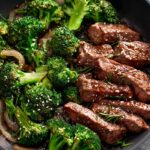The crispy shell. The umami-packed pork and veggie filling. The satisfying crunch with each bite. These homemade spring rolls are everything your takeout dreams are made of – and better, because you made them yourself.
Perfect for entertaining or a fun family dinner, these spring rolls are surprisingly easy to make and freeze beautifully too. Whether you choose to fry them for that delicate, golden crisp or bake them for a healthier twist, the result is pure magic. Don’t forget the sweet and sour dipping sauce for the ultimate experience!
Full Recipe:
For the Filling:
-
1 tbsp oil
-
2 garlic cloves, finely chopped
-
400g (13 oz) pork mince (or chicken/turkey)
-
6 dried shiitake mushrooms, soaked and chopped (or 8 fresh)
-
1 ½ cups shredded carrot
-
1 ½ cups bean sprouts
-
1 ½ cups shredded green cabbage
-
1 tsp cornflour
-
1 ½ tbsp oyster sauce
-
2 tsp soy sauce
For the Rolls:
-
15–20 spring roll wrappers (21.5 cm / 8” squares), thawed
-
2 tsp cornflour
-
1 tbsp water
-
Oil for frying or spray oil for baking
For the Sweet & Sour Sauce:
-
2 tsp cornflour
-
2 tbsp water
-
½ cup apple cider vinegar
-
⅓ cup brown sugar
-
2 tbsp tomato ketchup
-
2 tsp soy sauce
Directions:
-
Heat oil in a skillet or wok over high heat. Add garlic and pork, stir-fry until meat is white.
-
Add mushrooms, carrot, bean sprouts, and cabbage. Cook for 3 minutes or until wilted.
-
Stir in cornflour, oyster sauce, and soy sauce. Cook 1 minute until liquid is gone. Cool filling.
-
Mix 2 tsp cornflour with 1 tbsp water to form a sealing paste.
-
Place a wrapper smooth side down in diamond position. Add a heaped spoon of filling, roll halfway, fold in sides, roll to seal with paste.
-
Heat oil in a wok or pan until bubbles appear around a chopstick.
-
Fry 4–5 spring rolls at a time until deep golden (1½–2 minutes). Drain on paper towels.
-
For baking: Place rolls on a rack over a tray, spray generously with oil, bake at 200°C/400°F for 20–25 mins.
-
For the sauce: Combine all ingredients in a saucepan. Simmer 3–5 mins until thickened.
Prep Time: 20 minutes | Cooking Time: 10 minutes | Total Time: 30 minutes
Kcal: 176 kcal per roll | Servings: 15–20 spring rolls
The Art of Making Authentic Spring Rolls
Few things delight the senses like biting into a perfectly crisp, golden spring roll. That satisfying crunch followed by a burst of flavorful, savory filling has earned spring rolls a permanent place in the world of beloved appetizers. While commonly found in Asian takeout menus, nothing quite compares to making them from scratch at home. This recipe, featuring a pork and vegetable filling wrapped in thin, flaky spring roll wrappers, is a celebration of homemade comfort, flavor, and texture.
What Makes These Spring Rolls Stand Out
Unlike the overly greasy, limp versions sometimes found in food courts or lower-end restaurants, this homemade version focuses on quality and texture. The exterior is shatteringly crisp, golden, and light, achieved through proper wrapping technique and frying (or baking) methods. Inside, the filling is thoughtfully crafted—juicy, savory, and bursting with a medley of textures from ground meat, vegetables, and mushrooms. The flavor is balanced, with umami depth from oyster sauce and soy sauce, slight sweetness from the vegetables, and a gentle aroma of garlic.
What truly elevates these spring rolls is the use of shiitake mushrooms, which lend a rich, earthy umami flavor. Whether you opt for dried (rehydrated) or fresh mushrooms, they enhance the overall taste profile and add a layer of complexity often missing in takeout versions. The balance between the meaty filling and fresh, crunchy vegetables such as carrots, cabbage, and bean sprouts is also key—it’s not just flavorful, it’s texturally delightful.
Why Spring Rolls Are a Universal Favorite
Spring rolls are more than just a dish—they’re a cultural symbol of sharing, celebration, and festivity across many Asian cultures. From Lunar New Year to family gatherings and potlucks, spring rolls are often part of the spread. Their versatility in terms of fillings also makes them a favorite across different palates and dietary preferences.
For those who love a hands-on cooking experience, making spring rolls from scratch can be both therapeutic and rewarding. The process of assembling, wrapping, and cooking them invites creativity and is a fun activity for families or group gatherings.
Crispy or Baked: Choose Your Cooking Method
While traditionally deep-fried, spring rolls can also be baked or air-fried with great success. Frying provides that signature golden crisp with a delicate flakiness, whereas baking delivers a lighter version that’s still crunchy but slightly less flaky. For health-conscious eaters, baking offers a guilt-free way to enjoy this classic snack without sacrificing too much on texture or flavor.
An essential tip for baking spring rolls is to generously spray them with oil and bake them on a wire rack. This ensures they crisp up evenly without the need for flipping and prevents sogginess.
The Secret Behind the Perfect Filling
The filling in this recipe doesn’t aim to be overly complicated. What makes it exceptional is the careful consideration of each component’s moisture content, cook time, and how it complements the rest. The vegetables are sautéed just long enough to soften, not to the point of being mushy. The meat is browned until flavorful, and the mushrooms are finely chopped to blend seamlessly while adding depth.
One critical detail is ensuring the filling is cooled completely before wrapping. Warm filling can cause the wrapper to become soggy or tear, resulting in burst spring rolls when frying. For those new to making spring rolls, this is an important step that cannot be skipped.
Another handy tip is using a simple paste of cornflour and water to seal the wrappers securely. This keeps the filling intact during cooking and prevents any messy oil splatters.
Mastering the Art of Wrapping
Don’t be intimidated by the idea of wrapping spring rolls—it’s easier than it looks, and after a few tries, you’ll develop a rhythm. The trick is to position the wrapper like a diamond, place the filling near the bottom, roll tightly halfway, fold in the sides, and finish rolling up before sealing. Keeping the wraps tight but not overfilled is key to even cooking and maintaining structure.
Spring roll wrappers used in this recipe are wheat-based and typically found in the freezer section of Asian grocery stores or larger supermarkets. They’re easier to work with than rice paper and result in that signature crisp exterior. If you want to make the rolls gluten-free, you can experiment with rice paper wrappers, although the texture will be different and more translucent.
A Sauce That Complements Every Bite
No spring roll experience is complete without the perfect dipping sauce. This recipe includes a simple yet irresistible sweet and sour sauce made from pantry staples like apple cider vinegar, brown sugar, tomato ketchup, and soy sauce. It adds a tangy punch that cuts through the richness of the fried rolls, creating a harmonious bite every time.
While store-bought sauces are convenient, making it yourself takes only a few minutes and makes a noticeable difference. You can tweak the sweetness, acidity, or saltiness to suit your taste, making it more personalized and authentic.
Customizing the Filling to Suit Your Taste
Another reason to love spring rolls is how customizable they are. While this version uses pork mince, you can easily swap in ground chicken, turkey, shrimp, or make them completely vegetarian or vegan. Common additions include vermicelli noodles, tofu, and additional veggies like bell peppers or mushrooms.
For those looking for spicier variations, adding chili garlic paste or a splash of sesame oil can elevate the flavor profile. The base recipe is wonderfully adaptable to seasonal ingredients, making it easy to turn this into your go-to appetizer or snack year-round.
Perfect for Batch Cooking and Freezing
Spring rolls are one of the best candidates for meal prep. They freeze well before cooking, allowing you to fry or bake them straight from frozen without thawing. This makes them an excellent make-ahead snack or appetizer for parties, gatherings, or quick weeknight meals.
To freeze, place the assembled (but uncooked) rolls on a tray lined with parchment, freeze until solid, then transfer to a freezer-safe bag. When you’re ready to cook, take them straight from the freezer to the fryer or oven.
Serving Suggestions and Pairings
Spring rolls are incredibly versatile in how they can be served. While they shine as an appetizer, they also work well as part of a dim sum spread, alongside noodle dishes or stir-fries, or even served over a fresh salad for a fusion twist.
Pair them with light, refreshing beverages like jasmine tea, chilled white wine, or sparkling water with lemon. For a fuller meal, serve them alongside fried rice, lo mein, or a warm broth-based soup.
If you’re hosting a party, consider offering a spring roll bar where guests can choose their own fillings or dipping sauces—it adds a fun interactive element and is always a crowd-pleaser.
A Homemade Experience Worth Mastering
There’s something incredibly satisfying about biting into a spring roll you made yourself. Not only do they taste better than most restaurant versions, but they also reflect the care and love put into each roll. Whether you’re entertaining guests, preparing a special dinner, or simply treating yourself, homemade spring rolls are an impressive and delicious choice.
They’re the kind of recipe that improves with each batch—once you get comfortable with the process, it becomes second nature. The ability to customize them makes them adaptable to every taste and dietary preference, and the reward of that first crispy bite makes all the effort worthwhile.
Conclusion
Making spring rolls at home is a culinary adventure that combines creativity, culture, and technique. From choosing your filling ingredients to mastering the art of wrapping and cooking them to golden perfection, each step is an invitation to slow down and savor the process. Unlike their commercial counterparts, homemade spring rolls are crisp, flavorful, and bursting with fresh, real ingredients.
Whether you’re a home cook exploring Asian cuisine or a seasoned foodie looking for your next kitchen triumph, this spring roll recipe delivers on all fronts—taste, texture, and visual appeal. Try it once, and it’s bound to become a staple in your cooking repertoire.





